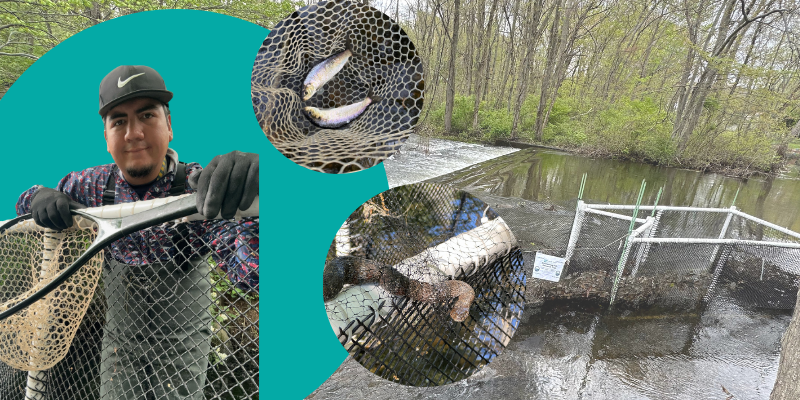Each year, Save the Sound hires a seasonal fisheries technician to help our ecological restoration team monitor our fish traps in Connecticut rivers. The effort helps us understand the health of the spring fish run and its comeback, specifically on the West River in New Haven after our removal of Pond Lily Dam in 2016.
This year, Nicolas Acuna Perales joined our team to take on the challenge. We spoke with him to learn more about why this position was a good fit for him and what exciting things he’s seen on the river.

Q: Can you tell us a bit about what you were doing before coming to Save the Sound?
Nico: For the last year, I had been working at the Maritime Aquarium as a science educator. I would tell visitors about the species of marine life in the northeast US and their importance in the food chain and ecology of aquatic ecosystems.
Before that, I was in my home country, Peru. I graduated with a biology degree and had been working as an associate researcher and educator at a non-profit called ProDelphinus for eight years. There, I was involved in the conservation of endangered marine species of the South Pacific, specifically species that get caught as bycatch like sea turtles, dolphins, and whales. I conducted many research projects, from the trophic ecology of hammerheads to satellite tracking of hawksbill and leatherback sea turtles. I also spent a lot of time educating fishermen, their spouses, and children on the importance of each of these species and worked to change the mindset around bycatch.
Q: What attracted you to this position at Save the Sound?
Nico: When I came to the US, I realized that I needed to gain knowledge on a completely new set of marine life that lives in the northern Atlantic. The job at the Maritime Aquarium introduced me to those species, but I wanted to get more involved in field work and research. That’s when I found the position at Save the Sound. The opportunities to set fish traps, collect fish run data, and even assess culverts for fish passage are really exciting for me because it is a chance to be involved in actionable research.
Q: What does a typical day look like as a seasonal fisheries technician?
Nico: After learning all about fish migration in Long Island Sound from [Save the Sound staff fisheries biologist] Jon Vander Werff, who is an extremely inspiring and knowledgeable teacher, we set up fish traps on a few rivers. Since then, I have been monitoring the one on the West River, upstream of the Pond Lily Dam removal site. I wade into the river each morning and check the trap for fish. After taking some photos and marking down the number and species of fish and other wildlife, I enter that data into a database we’re compiling. Most days are a combination of fieldwork and office work, a complete experience for someone starting out in fisheries research.
Q: What kinds of fish are you catching in the trap?
Nico: We have been fortunate to have caught 56 alewife so far. Alewife are river herring and a top priority species for the health of the riverine and ocean ecosystems; many species of other fish and wildlife depend on them in their diets. Other common fish I catch are black crappy, white sucker, golden shiner, and chain pickerel.
Q: Are fish the only animals you catch in the trap?
Nico: No! I found a painted and a musk turtle as well as an unexpectedly high number of snakes! I have already encountered four snakes in the trap. Three of which were stuck, intertwined in the mesh of the trap. I called Jon for advice on how to free them. He let me know they were not venomous, but could be aggressive, and I found that out as I tried to free one of them. I carefully cut pieces of the mesh away while blocking the snake’s head to avoid getting bitten. Luckily, I was able to do it quickly and precisely enough for the snake to escape unharmed. Fish, turtles, snakes…it’s always an adventure going to check the trap!
[Note: This is one of the reasons Nico and Jon check the traps so frequently—it’s important to release wildlife quickly and make sure no harm comes to them.]
Q: With your international experience in marine biology, what kind of advice would you give someone pursuing this path?
Nico: If you enjoy being outdoors and doing fieldwork, this line of work will provide a real connection with the environment and wildlife. The role at Save the Sound is perfect for people entering this kind of career because it teaches you how to collect data for a real research project on alewife conservation. The role itself is helping these important fish complete their lifecycle. This role has also taught me how to assess culverts for fish and wildlife passage, something I did not expect to learn here. If you are just starting off, it’s important to try many different types of roles in research, and this position will give you a taste of multiple aspects of restoration projects. I’d encourage anyone with a background in environmental science or fish biology to check it out!
Summer research positions for 2023 are full, but our ecological restoration and water quality programs will have more seasonal openings in the future. Find all open permanent and seasonal jobs, internships, and RFPs at www.savethesound.org/about-us/jobs-rfps.
